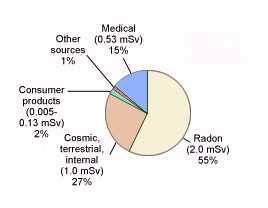Background radiation
In our daily life, we are exposed to various types of naturally occurring radiation from cosmic rays, from radioactive substances in the earth, and from naturally occurring radiation in our bodies. This is commonly referred to as background radiation. The combined annual dose from these sources is thought to range from 0.001 to 0.003 sievert (or from 1 to 3 millisievert [mSv]).
In addition, the same level of radiation is thought to be received annually from radon, but the amount varies considerably depending on the geographic area and the type of building.
The radiation dose from chest radiography is a fraction of the annual naturally occurring background radiation dose,1 and the dose from fluoroscopy of the stomach is, at most, 0.05 Sv on the skin of the back.
Shown in the figure below are the average annual radiation doses received per capita in the United States2 from naturally occurring and manmade sources of radioactivity. The total yearly dose is approximately 0.0036 Sv (3.6 mSv).

Figure. Annual background radiation doses in the United States
